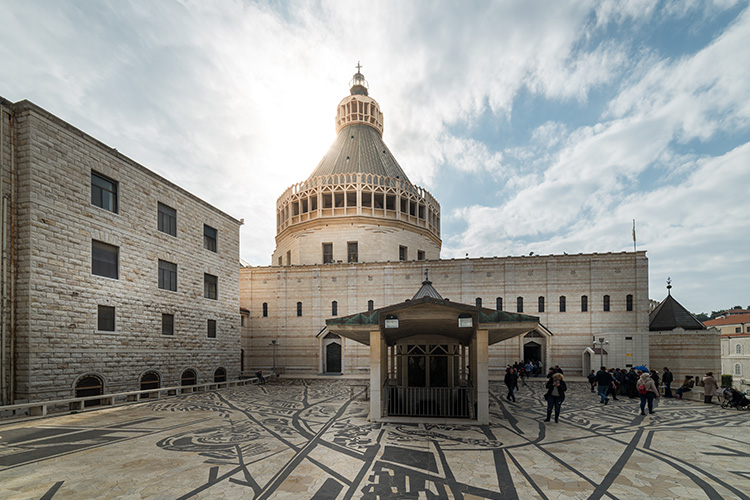Annunciation Church Franciscan Custody
"The angel went to her and said: Greetings, you who are highly favored! The Lord is with you". (Luke 1:28)
Despite the importance of Nazareth in the lives of Jesus and his parents, it did not immediately become a place of Christian pilgrimage. The first shrine was probably built sometime in the middle of the 4th century.
The Spanish pilgrim, the Lady Egeria, who visited Nazareth in 383, was shown a "big and very splendid cave in which Mary lived. An altar has been placed there." This was probably the larger of the caves enshrined in the grotto of the present Basilica of the Annunciation. By Roman Catholic tradition, it is the place where the angel Gabriel appeared to Mary.
By 570, a church had been built on the site. A 4th- or 5th-century Greek mosaic inscription was found, with the dedication: "For Conon, Deacon of Jerusalem".
Pilgrims to Nazareth in the Byzantine period were also shown a cave with a spring from which Mary drew water (possibly the spring beneath the present Greek Orthodox Church of the Archangel Gabriel), and the "synagogue" where Jesus read from Isaiah. Various accounts mention church buildings at all three sites. These early churches apparently survived the Arab conquest, because the pilgrim Arculf, a bishop from Gaul visiting in 670, saw two "very large churches" in the town. But by the time of the Crusader conquest in 1099, all the Christian holy places in Nazareth were in ruins.
The Norman knight Tancred, Prince of Galilee, immediately ordered the construction of a new cathedral above the cave in the center of the town. It was the largest of the Crusader-built churches, and the Anglo-Saxon pilgrim Saewulf, visiting in 1102, described it as "a very noble monastery" (he also reported that the town had been entirely laid waste by the Saracens). This Crusader cathedral was apparently damaged by the earthquake in 1170. Repairs began, but were not complete when the Crusaders suffered defeat at the Battle of Hittim and were expelled from the town.
A series of subsequent treaties allowed continued Christian pilgrimage to the Grotto of the Annunciation during the next hundred years, even after 1263, when the town was sacked and the churches destroyed by order of the Mamluk sultan Baybars. The possibility of pilgrimage came to an end in 1291 with the fall of Acre and the final expulsion of the Crusaders from the remaining Frankish settlements and fortresses along the coast.
A Roman Catholic clerical presence in Nazareth was not re-established until 1620 when the Druze emir Fakhr-a-Din permitted the Franciscan fathers to purchase the ruins of the Crusader cathedral and grotto. In 1730, the Franciscans obtained a firman (decree) from the Ottoman sultan allowing them to build a new church on the site. This structure was enlarged in 1877, and then completely demolished in 1955 to allow construction of a new basilica. Before the start of actual building, a thorough archeological investigation of the site was carried out by the Studium Biblicum Franciscanum (Jerusalem).
Designed by the architect Giovanni Muzio, the present Basilica of the Annunciation is built on two levels. The upper level follows the outline of the 12th-century Crusader- cathedral (a nave, flanked by two aisles), and partly reconstructs the eastern apses. The lower level enshrines the Byzantine grotto.
The new basilica, the largest Christian sanctuary in the Middle East, was dedicated in 1964 by Pope Paul VI during his historic visit to the Holy Land, and consecrated on 23 March 1969. A second, ecumenical service two days later included the participation of prelates and clergy from the Greek Orthodox, Armenian, Coptic, Ethiopian, Syrian and Lutheran churches.
The second church was built over the ruins of the Byzantine era church during the Crusades, following the conquest of Nazareth by Tancred in 1102. The Crusader era church was never fully completed. Five Romanesque capitals carved by artists from northern France, and discovered during excavations in 1909, had not yet been installed in 1187 when news of Saladin's victory in the Battle of Hittin reached the city. Saladin granted permission to Franciscan priests to remain in Nazareth to oversee services at the church. In 1260, Baybars and his Mamluk army destroyed the church during their attack on Nazareth. A small number of Franciscans managed to stay in Nazareth until the fall of Acre in 1291. In the three centuries that followed, the Franciscans were in and out of Nazareth, depending on the local political situation, which was constantly in flux. Franciscan accounts of this period document their expulsion in 1363, their return in 1468 and a massacre of some of their members in 1542. Local Christian families with Franciscan support helped take care of the church as well during this period.
Emir Fakr ad-Din granted the Franciscans permission to return in 1620, at which time they constructed a small structure to enclose the holy grotto that is venerated as the house of Mary. In 1730, Dhaher al-Omar permitted construction of a new church, which became a central gathering place for Nazareth Latin community. The church was enlarged in 1877, and then completely demolished in 1954 to allow for the construction of a new basilica, which was completed in 1969. The new basilica was designed by the Italian architect Giovanni Muzio, and built by the Israeli building firm Solel Boneh during the years 1960-69. Used by the Latin parish, it remains under the control of the Franciscans. It is the largest Christian sanctuary in the Middle East, and was dedicated in 1964 by Pope Paul VI.






Comments
Post a Comment